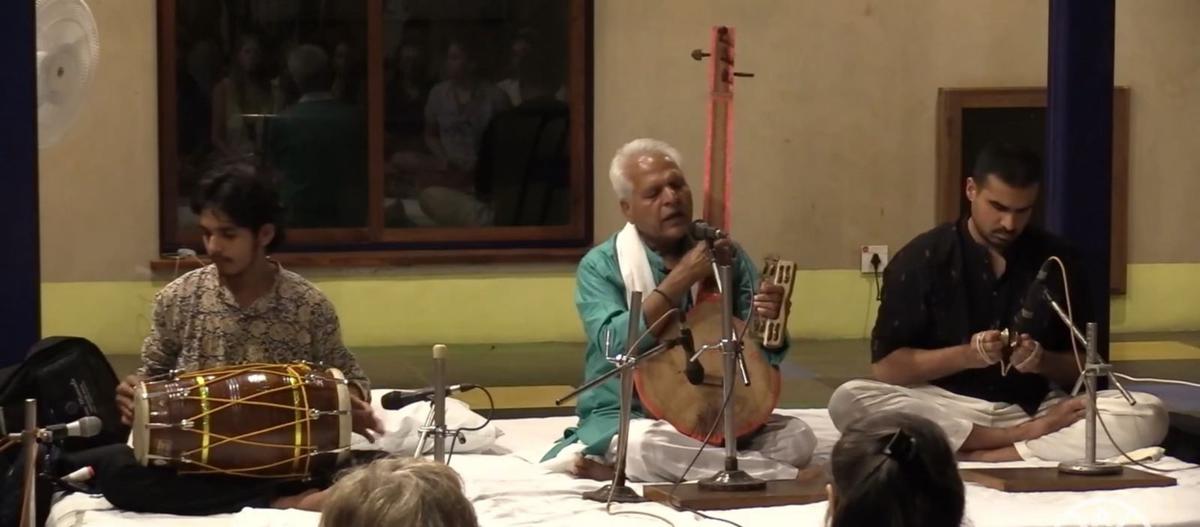
Folk singer Prahlad Singh Tipanya rendered Kabir bhajans at the Auroville Language Lab during a recent tour of the city.
| Photo Credit: Special Arrangement
Verse, when transformed to the form of a hymn, gains considerable power to move the mind and touch the soul, says Prahlad Singh Tipanya, folk singer, who is regarded as among the foremost voices of 15th century mystic poet Kabir.
Tipanya, who was in the city recently to perform a series of bhajan sessions/satsangs at different settings, is a legatee of a six centuries-old tradition of the Malwa folk singers of rendering Kabir’s couplets in “bhajan mandlis”.
A retired schoolteacher hailing from the village of Luniyakhedi, he is these days more of an itinerant artist whose satsang journeys to popularise the Kabir repertoire have struck a chord in audiences across India, and abroad, spanning differences of age, language, gender and faith.
“The Kabir bani with its centuries-old origins transcends the bounds of time and the theological…. at its core the message is both unifying and universal,” Tipanya said during an interaction after a satsang at the Aurodhan Art Gallery.
During his visit to the city, the artist, accompanied by his grandson Himanshu Tipanya on the dholak, rendered Kabir dohas (couplets) in a typically rustic song-and-story-telling style, adding interpretations, and modern-day analogies relatable to the audiences.

Folk singer Prahlad Singh Tipanya rendered Kabir bhajans at the Auroville Language Lab during a recent tour of the city.
| Photo Credit:
Special Arrangement
The tour included sessions at Aurodhan, Kariappa House and the Auroville Language Laboratory and a visit to the pilgrim hub of Tiruvannamalai near here.
Tipanya, who is the recipient of the Padma Shri (2011) and the Sangeet Natak Akademi Award (2007), has evolved a unique way of conveying the essence of Kabir’s “dohas” or couplets that combine deep spiritual significance resonant with Sufi thought, with stringent social commentary. (Exemplifying this aspect is a bhajan like, say, “Nirbhay Nirgun Gun Re”–that got amplified in the voice of Hindustani vocalist Pandit Kumar Gandharva–where the descriptors of the external actually represent an inner journey to truth and realisation.)
Kabir’s verse bears a truth far beyond what the words convey in a literal sense and Tipanya explains at length the higher-order import of the textual. The sant’s conceptualisation of Ram and Rahim as belonging to the entire humanity, the virtue of guru-bhakti, the fallacy of material pursuit or the exhortation to look inward to seek the real truth are recurring themes in these sessions.
Tipanya is convinced that as societies become increasingly fissured along lines of caste and creed, Kabir’s preachings turn more and more relevant. He also feels that the couplets can be interpreted to serve as a self-help tool, a life code or a navigation guide through a material world for everyone to emerge as better humans.
“The fervid appeal for total devotion, of selfless surrender, that defines Kabir’s poetry shines a light on the path to evolve into a better humanity”, he said. However, the most important first step to self-actualisation, as he emphasises, is to understand the essence of the godliness that resides within everyone.
As Mita Radhakrishnan of Auroville Language Laboratory, who hosted the session noted, there is no “show” or “concert” side to these encounters with Kabir; they are immersive experiences of harmony and togetherness in the presence of “sat,” the truth. “One even doesn’t really have to know Hindi to appreciate (it) and be moved by the music and the message”.
Stay connected with us on social media platform for instant update click here to join our Twitter, & Facebook
We are now on Telegram. Click here to join our channel (@TechiUpdate) and stay updated with the latest Technology headlines.
For all the latest Art-Culture News Click Here
